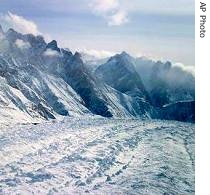2007年VOA标准英语-US Scientists Say Pollution Accelerates Melting(在线收听)
Hong Kong
05 August 2007
U.S. scientists say clouds of man-made haze that blanket southern and eastern Asia are helping accelerate the melting of the Himalayan glaciers. VOA's Heda Bayron reports from our Asia News Center in Hong Kong on the effect of these so-called "brown clouds" on the region's climate.

An aerial view of the Siachen Glacier, northwest of Jammu, India
A team from the Scripps Institution of Oceanography in California used unmanned aircraft to measure heat in the atmosphere high above the Indian Ocean, a part of Asia often blanketed by "brown clouds" of man-made pollution.
Brown clouds are known to cool the land or sea below them because they trap sunlight, not allowing it through to the earth below. Until now, however, little has been known about the clouds' effect on the air immediately around them.
The Scripps team found that the brown clouds increased the heat of the air around them by around 50 percent. The team says the clouds have contributed roughly half of the temperature increase that has been blamed for the melting of the Himalayan glaciers.
"What we discovered from our measurement was the brown cloud was absorbing a lot of sunlight and was contributing to heating of the air," said V. Ramanathan, the chief scientist of the research team. "We put this data in a climate model and that model suggested that the warm air was contributing to glacial melt."
Brown clouds are made up of tiny particles called aerosols that come from, among other things, forest fires, vehicle and industrial emissions, and the burning of wood and cow dung for cooking that is common in many households in developing Asia.
"It's basically the smoke. The smoke carries these particles, and the atmospheric winds transport it so that we see [in] satellite data the brown cloud covering [the] entire South Asia and East Asia region and go over the ocean so that they intercept sunlight and modify the climate," added Ramanathan.
Experts say the loss of the Himalayan glaciers could mean water shortages for millions in Asia. The glaciers of the Tibetan plateau are the main source of the region's major rivers such as China's Yellow River, Southeast Asia's Mekong and India's Ganges.
In May, Greenpeace in China said Mount Everest was heating up at triple the world's average. Some scientists say at the current rate of warming, the Himalayan glaciers could disappear by 2035.
Ramanathan says one way to reduce brown clouds is to start using solar-powered cookers in millions of Asian households.